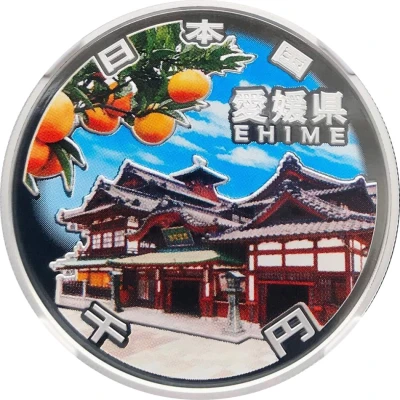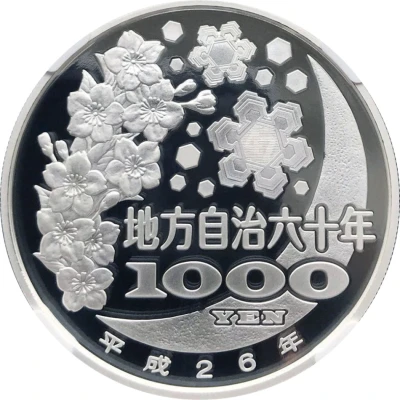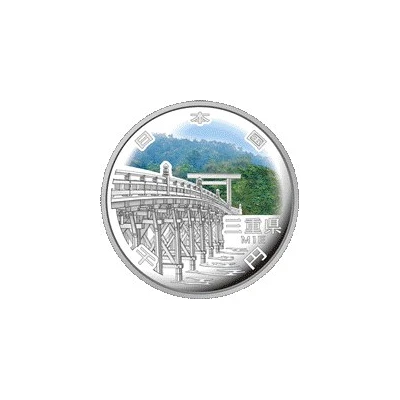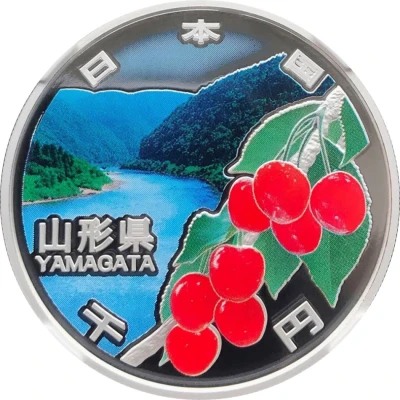
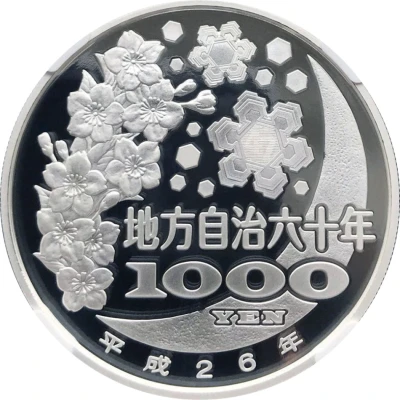

© coinsupermarket2012
1000 Yen - Heisei Yamagata
26 (2014) year| Silver (.999) | 31.1 g | 40.0 mm |
| Issuer | Japan |
|---|---|
| Emperor | Heisei (1989-2019) |
| Type | Non-circulating coin |
| Year | 26 (2014) |
| Calendar | Japanese - Heisei era |
| Value | 1000 Yen 1000 JPY = USD 6.72 |
| Currency | Yen (1871-date) |
| Composition | Silver (.999) |
| Weight | 31.1 g |
| Diameter | 40.0 mm |
| Thickness | 3.5 mm |
| Shape | Round |
| Technique | Milled, Coloured |
| Orientation | Medal alignment ↑↑ |
| Updated | 2024-10-05 |
| Numista | N#123686 |
|---|---|
| Rarity index | 87% |
Reverse
Cherry blossoms, crescent and snowflakes.
Latent images in largest snowflake.
Lettering:
(47/60)
地方自治六十年
1000
YEN
平成26年
Translation:
60 years of local autonomy
1000
Yen
Year 26 of Heisei
Edge
Slanted reeding right
Comment
Mogami River is a river with a total length of 229 km. During the Edo Period (1603-1868), main products of the inland area of Yamagata prefecture, such as rice, safflower and etc., were transported by this waterway to the mouth of the river, namely, the port of Sakataminato, and then shipped from there to Kyoto or Osaka via the sea route. In this way, the river has greatly contributed to the daily life and culture of the residents of the prefecture since long time ago. It is also known as one of the rapidest rivers in Japan. "Samidare-wo, atsumete-hayashi, Mogami-gawa (Gathering the rains of May, Mogami River flows rapidly)," a famous haiku (Japanese seventeen-syllable poem) made by MATSUO Bashō, also refers to the rapidness of the river’s flow.A kind of cherry, known as Sakuranbo cherry, is a fruit of Mizakura. At present, about 70 percent of the gross production of the Sakuranbo cherry in Japan (about 13,200 tons) is produced in Yamagata Prefecture. Satōnishiki, a breed of the Sakuranbo cherry, whose production volume in Japan is the largest of all the cherries, was produced by breeding in Yamagata Prefecture. In addition, Mizakura cherry tree is designated as a tree of the prefecture.
Interesting fact
The 1000 Yen - Heisei (Yamagata) 26 (2014) coin from Japan features a unique design that showcases the country's rich cultural heritage. The obverse side of the coin depicts a beautiful image of Mount Zao, a famous mountain located in Yamagata Prefecture, which is known for its snow-covered peak and scenic beauty. The reverse side of the coin features a stunning image of a Japanese pheasant, a bird species native to Japan that is known for its vibrant plumage and graceful appearance. The coin's design is a celebration of Japan's natural beauty and cultural heritage, making it a highly sought-after collector's item for coin enthusiasts and collectors of Japanese culture.
Price
| Date | Mintage | VG | F | VF | XF | AU | UNC |
|---|---|---|---|---|---|---|---|
| 26 (2014) | 100000 | - | - | - | - | - | - |
Values in the table are based on evaluations by sales realized on Internet platforms. They serve as an indication only for 1000 Yen - Heisei (Yamagata) 26 (2014) coin.
